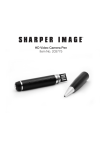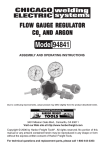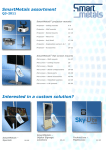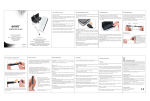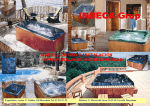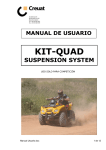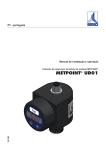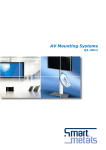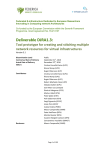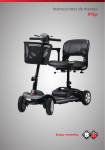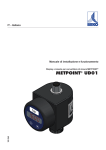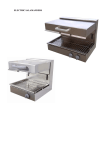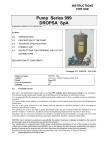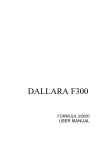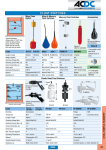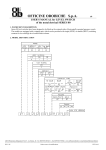Download CREUAT RCS Lleida
Transcript
CREUAT RCS (Roll Control System) By Lleida-Tracció PRODUCT MANUAL 1 de 12 INDEX First considerations ..................................................................... 3 Delivered components ................................................................. 3 Contacts .................................................................................... 3 1.- INTRODUCTION ..................................................................... 4 2 – ANTECEDENTS. ..................................................................... 5 3 – SYSTEM DESCRIPTION. .......................................................... 6 4 – SYSTEM ADVANTAGES. .......................................................... 8 5.- SYSTEM INSTALLATION GUIDELINES.......................................10 6.- MAINTENANCE AND REPAIR ...................................................11 6.1 – Check points...................................................................11 6.2 – Repair............................................................................12 6.3 – Revision and maintenance intervals ...................................12 2 de 12 First considerations Ø Before installing the kit, please read carefully this manual. Ø Installation, maintenance and repair operations that involve disassembling or manipulating the system can only be performed by certified CREUAT centers such as LLEIDA TRACCIÓ Ø The suspension is a vital element for all vehicles safety, it is paramount to relay on professional service teams to perform the system installation and periodic revisions. Delivered components The RCS KIT is delivered with the components as listed below: Ø Installation Manual (copy for the Shop) Ø User Manual (copy for the end user) Ø The CREUAT system that includes one Central Device connected to 2 hydraulic actuators by means hydraulic hoses Contacts OFFICIAL TECHNICAL SERVICE CREUAT, S. L. LLEIDA TRACCIÓ TECHNOLOGY, S. L. c/Montseny, 16 08956 La Palma de Cervelló c/Sicoris, 20 25001 Lleida Tl: 936 721 221 Fax: 936 721 053 Tl: 973 204 193 Fax: 973 213 651 Mail: [email protected] Web: www.creuat.com Mail: [email protected] Web: www.lleidatracciotechnology.com 3 de 12 1. - INTRODUCTION This Installation Manual is aimed to the personnel that does the installation of the RCS KIT to a vehicle. The purpose of this manual is to provide the installation guidance, understand the operating instructions, as well as the necessary information related to the basic maintenance and failure detection. This document will describe the system layout, how to install it and do the maintenance. The RCS KIT replaces the shock absorbers with two actuators interconnected through a central device. The interconnection is made of flexible hoses that easy the installation process and deal with the small actuator movements caused by the suspension movements. Once installed, the RCS KIT is immediately operative and requires no further manipulations. We are sure that you will enjoy driving your vehicle right after the suspension system has been installed on it. 4 de 12 2 – ANTECEDENTS Motorhome and ambulance manufacturers often use chassis from light trucks to build them on, with some adaptations due to the needs of the market. These chassis normally incorporate leaf springs and shock absorbers in the rear axle, which were neither designed for the high center of masses of these vehicles, nor to provide comfort for passengers. It is a fact that customers often replace it with air suspension or more sophisticated systems in pursue of better comfort and driving safety. In general, a suspension designed for the transportation of goods rarely takes into consideration any comfort parameter that relate to the transportation of persons. The most widely adopted solution is a rigid axle that always reduces the dampers effectiveness to control roll. Often these vehicles are delivered with a rather stiff rear suspension to cope with large variations of load and, without much subtlety, to covertly fix an inherent instability component. Motorhomes and ambulances are characterized by a high center of masses and large roll inertia. This makes them prone to roll over and quite unstable at moderate driving speed. So far the only solution is to make it stiffer to reduce the roll movements, which in turn destroys any comfort that was left. The alternative to maintain a bare minimum comfort would impair stability and create an important safety issue. The RCS KIT provides different damping rates for roll and vertical movements, so it can solve the problem of providing the right roll damping while keeping soft vertical suspension rates and maintain the comfort level. The RCS KIT also provides different bound and rebound damping rates. This helps to increase the comfort perception and reduces the pitch movements on braking. 5 de 12 3 – SYSTEM DESCRIPTION The RCS KIT is a hydropneumatic system that replaces the shock absorbers in a vehicle axle, usually the rear one. It does not include sensors or actuators, and reacts instantaneously to wheel movements. It is designed to provide separate response to roll and vertical movements, appropriately controlling both movements with distinct inertias. Hydraulic cylinders Central device The RCS KIT mounts two hydraulic actuators replacing the former dampers, attached to the existing damper supports. They are connected to a central device with flexible hoses. The system requires no further manipulation and once installed is ready to use. The system does not interfere with any other suspension element. It is totally compatible with the existing antiroll bar, spring leafs or even air suspension bags that have been added or replaced former springs. 6 de 12 The system elements have to be installed with strong fixtures in a way that it stays away from hot spots, such as the exhaust, and is protected from debris coming from the road. Hoses have to avoid sharp bents and fixtured to allow the movements induced by the tilting of the rams. Hydraulic cylinders Central device The system may come configured for the installation in the rear axle, the front or both. Please note that the system is preconfigured for the right vehicle model and the front or rear axle: The system can be installed on either the chassis or the axle. The axle mounting is preferable as the cylinder rods are better protected from the road debris. 7 de 12 4 – SYSTEM ADVANTAGES The ability to arbitrarily increase the roll damping is the key to the advantages provided by the RCS system A conventional system suffers from the fact that the vehicle requires extra roll damping and the suspension geometry reduces the dampers effectiveness to roll. The graph below shows a typical frequency response of a conventional system, showing the pitfalls of both hard and soft approaches 8 de 12 Conventional system can never approach an optimal solution. Dampers should provide a much harder damping to roll to compensate both the extra roll inertia and the low effectiveness of damper mounting locations. Roll movement frequency response Vertical over damping problem has not only a negative impact on comfort, it overloads the tire with all suspension work as suspension will not absorb road irregularities (note how blue and red curves almost coincide, so all suspended mass movements equal the tire deflection). Soft settings leave roll movement totally uncontrolled. Vertical movement frequency response The RCS KIT advantages can be resumed as a) Body Control: Ø Increased stability (against wind) Ø Improved handling (corners and roundabouts) Ø Vehicle Dynamics Complete Control of Design b) Comfort & Safety: Ø Soft vertical stiffness increases perceived comfort Ø Reduced Tire load peaks 9 de 12 5. - SYSTEM INSTALLATION GUIDELINES The system is designed for an easy, clean and quick installation. The kit is delivered purged, pressurized and tested, and the installation works are limited to the original damping replacement and proper fixturing of all the elements. The system rams come totally elongated. This means that the damper replacement may require lifting the vehicle and eventually pulling the fixturing points to achieve the appropriate distance between them. Installation procedure: 1. Safely raise the vehicle with the hoister until wheels lose contact with the floor. 2. Unassemble the shock absorbers and remove them. 3. Mount the hydraulic cylinders in the shocks absorbers place. 4. Position and fix the central device. Make sure the fixturing is strong and the chosen placement leaves the components away from hot spots, friction from moving parts and road debris, specially the hoses. Implement the necessary shields if necessary. 5. Fix the hoses tight near the central device, and ensure that the portion near the cylinders is lightly free 6. Lower the vehicle until all the weight is on the wheels. Check that no damage is made to the hoses during the wheel movement. 7. Check that there are no leakages and the flexible hoses are not in contact with any moving part. 8. The vehicle is ready to be used. 10 de 12 6. - MAINTENANCE AND REPAIR The RCS KIT, like any gas dampers, contains pressurized gas and oil, and is sealed from factory to prevent any leakage. Special care must be taken to prevent the system be damaged or accidentally opened as it can cause injuries. Flexible hoses are designed to stand internal overpressures, but keep them away from friction or sharp edges that may wear their external surface. The system does not require any servicing, but as any hydropneumatic system it is recommended to periodically review it and to ensure it is working safely. 6.1 – Check points Ø Cylinders: o Check the cylinder rods against scraps and damage by road debris. In particular the chromeplated rod surface should remain intact. Clean it thoroughly after off road to remove mud and any adhered material. o Check that the cylinder mount points are not damaged, bent or deformed in a way that impairs the normal cylinder tilting movement. o Check that there is no oil leakage from the sealing or near the hose connection Ø Hoses & Fittings o Check that there is no a hose damage or surface wear that indicates friction with moving parts or road debris impacts. o Check there is no leakages near the hose fittings Ø Central device and sphere o Check for impacts, oil leakages or fixture deformations. 11 de 12 6.2 – Repair The system is not repairable on site. If any malfunction, leakage, breakage or deformation is noticed, the entire system should be unmounted and sent for repair. If no replacement is available, mount the original dampers as a temporary measure To remove the kit follows the next steps: 1) Raise the vehicle until the wheels lose contact with the floor 2) Unscrew the cylinder mounting nuts 3) Pull if necessary the lower mount point until the cylinder bolts come free. Remove them and the cylinders from the mounting points. 4) Loose and remove the hoses and the central device 5) Proceed to install an alternative damping set. 6.3 – Revision and maintenance intervals AFTER TRIMES- HARD USE TRAL OUTSIDE CLEANING M CYLINDERS REVISION M ANNUAL R R CENTRAL DEVICE REVISION M R FLEXIBLE HOSES REVISION M R R R HYDRAULIC LEAKINGS R R GAS LEAKINGS R R FIXTURES AND BEARINGS REVISION M M= Maintenance: Visual inspection and cleaning. R= Revision: Through full inspection at a technical center. 12 de 12












